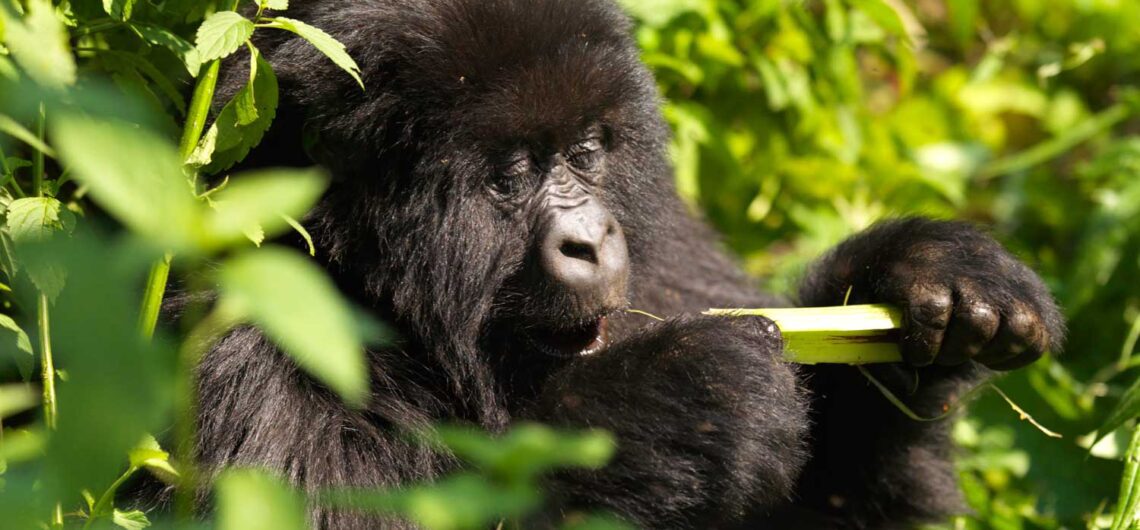Gorilla tracking differs from gorilla trekking in the following ways: Gorilla trekking and gorilla tracking are two key terms that often come to mind when it comes to traveling to Africa to see mountain gorillas. Many people have long been perplexed by the terms “gorilla trekking” and “gorilla tracking,” but what do they actually mean? The distinction between gorilla trekking and gorilla tracking is negligible.
Gorilla trekking and Gorilla Tracking
Gorilla trekking
Mountain gorillas can only be seen in Bwindi Impenetrable National Park and the Virunga Region by entering the dense tropical forests on foot (Virunga National Park, Volcanoes National Park and Mgahinga Gorilla National Park). This is always carried out under the direction of a knowledgeable park guide. For a visitor to have a satisfactory gorilla trekking experience, they must be physically fit. Because you immerse yourself in the forest, bamboo, and hikes take you to a high altitude, it is not like a typical on-foot walk experience.
Gorilla trakking
In most cases, gorilla trekking begins at 7:00 am with a briefing and assignment of a gorilla family by park rangers at the respective park headquarters or tourist centers. When tourists enter the forest to start hunting for their designated gorilla groups in the separate National Parks at 8:00 am, the actual trekking begins.
A single gorilla family may host up to 8 tourists, and participants must be 15 years of age or older. The length of the journey varies depending on a number of variables, including the gorilla family assigned to your party, the habitat’s characteristics, the terrain, and the tourists’ level of fitness. A maximum of one hour is allotted for you to observe, learn more about gorilla behaviors, and take pictures. The walk to view gorillas can run for 2–6 hours, depending on the factors described above, among others.
In contrast to gorilla trekking, gorilla tracking is carried out by qualified park rangers, trackers, and researchers. Different techniques or clues are utilized to trace where gorillas previously lived or stayed, and researchers or trackers go out early to look for a certain gorilla family.
Gorilla tracking is done for a variety of reasons, including research, population counts, and making it easier to find the families during treks with the primates. After a briefing at the park station, the trackers stay in constant contact with the guides, and once a group of visitors departs, the guide keeps in communication with the trackers so they may be easily directed to where a gorilla family is located.
In actuality, gorilla tracking comes first, then trekking. Because a gorilla monitoring crew always links up with the park guides on lead, visitor chances to encounter gorillas have doubled.
Where to go for gorilla tracking and trekking?
The majority of tourists travel to Africa to view mountain gorillas and eastern lowland gorillas in the wild; there are two gorilla species and four subspecies. Mountain gorillas and eastern lowland gorillas are two subspecies of eastern gorillas.
There are just 4 parks in Africa where tourists can go to observe mountain gorillas: Virunga National Park in eastern D. R. Congo, Bwindi Impenetrable National Park in southwest Uganda, and Volcanoes National Park in Northwestern Rwanda.
Rwanda’s Volcanoes National Park
Volcanoes National Park, one of Africa’s oldest parks established in 1925, is situated in the northern Ruhengeri region and covers 160 square kilometers of territory. There are 11 habituated gorilla groups in Volcanoes National Park, all of which are accessible to visitors on safaris to see gorillas in Rwanda.
Impenetrable National Park in Bwindi
One of the most popular parks in Africa for gorilla trekking is located in southwest Uganda. Bwindi was established as a national park in 1991 and then recognized as a UNESCO World Heritage Site in 1994. There are 18 gorilla groups or families in total in the four sectors of Uganda’s Bwindi Impenetrable National Park: Ruhija, Buhoma, Rushaga, and Nkuringo.
Mgahinga Gorilla National Park
This is the second location in the Pearl of Africa where a portion of the 1063 remaining mountain gorillas flourishes. It is found in the Kisoro district of south-western Uganda. With only 33.7 square kilometers of land, this is the smallest of the ten national parks in Uganda. Mgahinga National Park, like Bwindi, was initially established to provide as a habitat for mountain gorillas, and astonishingly, visitors can see both mountain gorillas and golden monkeys here.
Virunga national Park
The only place to observe mountain gorillas in Democratic Republic of the Congo is in Virunga, the country’s primary gorilla park. With its 1925 gazetting date and current population of 8 habituated gorillas, this park is also one of the oldest wildlife sanctuaries in Africa.


Comments